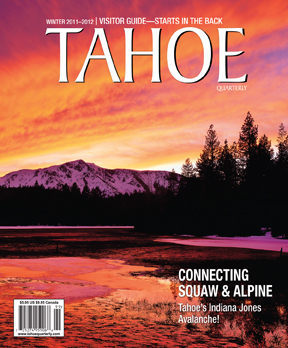Q&A with U.S. Senator Dianne Feinstein
A native of San Francisco, U.S. Senator Dianne Feinstein (D-California) was elected to the San Francisco County Board of Supervisors in 1969 and served two and a half terms as president of the board. She became mayor of San Francisco in November 1978 following the assassinations of Mayor George Moscone and Supervisor Harvey Milk and was subsequently elected to two four-year terms. Elected to U.S. Congress in 1992, Senator Feinstein has long been a vocal advocate for The Lake, returning to the region every summer since 1997 for the Tahoe Summit.
How far back does your connection with Tahoe go?
As a youngster I visited Tahoe virtually every summer. For two summers I was a camper at Talawanda camp for girls, and I was able to take pack trips into the backcountry and really see the beauty that surrounds this great lake.
What are your fondest memories of times at Lake Tahoe?
My fondest memory is bicycling around The Lake at the age of 16. I remember we left Tahoe City, biked to Emerald Bay and spent the night at the campgrounds. I also remember my bike didn’t have brakes! Luckily, that was in the days when there were fewer cars.
How optimistic are you that we can return The Lake to its legendary clarity? What are the top obstacles to do so?
We face many challenges, foremost among them pollution and sedimentation. But there is some good news. In the past decade, we have seen improvements as a result of the erosion control work around the Basin. Last year, scientists found an average clarity of 68.1 feet, and scientists say the rate of decline in Tahoe’s clarity has halted.
Where does protecting Lake Tahoe rank in your understandably long list of priorities to state and country?
Protecting Lake Tahoe is an important part of my legislative legacy. It is truly the crown jewel of the Sierra and an important environmental and recreation destination for Californians. I want to make sure Lake Tahoe’s beauty can be enjoyed for many generations to come.
The Lake Tahoe Restoration Act, which you co-sponsored in 2000, has meant hundreds of millions of dollars for Tahoe’s protection and preservation. A bill to extend that by ten years is before Congress. How difficult is it to convince your colleagues of the importance of continuing that funding, especially in these tough economic times?
Lake Tahoe’s Environmental Improvement Program, or EIP, is private agencies and groups to leverage investments with the goals of improving water clarity and reducing the threat of wildfire. To my knowledge, it is the only large environmental restoration program to do so. This type of investment helps continue the restoration work without the same level of federal funding. I am very concerned about the federal deficit and I agree that we should invest in only the most essential projects. We will also need to see a significant effort by the private sector. I want to commend Art Chapman on creating the Tahoe Fund, which will raise philanthropic funding for on the- ground projects. I encourage every business owner, homeowner and tourist to consider donating to the Tahoe Fund. If you care about saving The Lake, it’s an excellent way to put private dollars in action.
Can you comment on how senators from both parties have worked together for Tahoe’s protection and restoration?
Lake Tahoe’s restoration has always been very much a bipartisan effort. In 1997, President Clinton and Vice President Gore attended the Lake Tahoe Presidential Forum and signed an executive order creating the EIP. In 1999, I introduced the Lake Tahoe Restoration Act with Senators Reid, Boxer and Bryan, which was signed into law in 2000. Later, in 2003, Senator John Ensign was instrumental in securing a dedicated funding source for Lake Tahoe, and this year I introduced the Lake Tahoe Restoration Act of 2011, cosponsored by Senators Reid, Boxer and Ensign. Senator Heller sponsored the bill in the House last year, and I hope he will sign on again this year.
What are the possible consequences if Nevada withdraws from the Tahoe Regional Planning Agency?
I have serious concerns about Nevada’s potential withdrawal. There could be several unintended consequences including increased cost for Nevadans to create and maintain a new state agency. It could also endanger the investments already made by the public and private sectors. Times are tough, but I don’t believe withdrawing is the solution.
What can we expect from this year’s Lake Tahoe Summit?
We are still planning the Tahoe Summit, but you can expect discussion about the future of Lake Tahoe, especially the need to prioritize future funding on the most important initiatives. I encourage local residents and homeowners to attend the Summit and be part of this critical discussion.
Favorite Tahoe spot?
Emerald Bay, especially the Tea House (Fannette Island). The vision I have of this elderly woman rowing out there every day to have tea—there’s nothing like it anywhere in the world. By Susan D. Rock. TQ.
Category: Current Issue, Uncategorized







